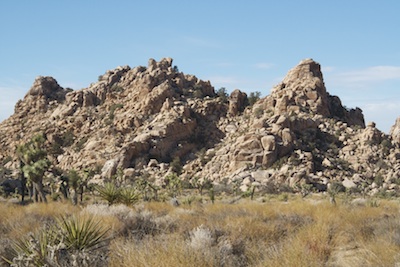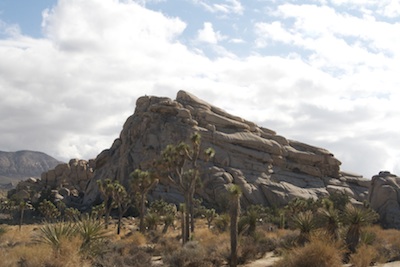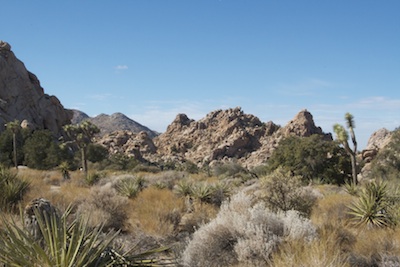
Valley is gem at center of Joshua Tree
TWENTYNINE PALMS, Calif. – If the mountains, valleys and eerie seclusion and remoteness that embody Joshua Tree National Park were not enough to take in at first sight, pay a visit to the Hidden Valley Trail… a secluded sanctuary with an interpretive trail in the heart of the park, with a campground just across the road, and Barker Dam just minutes away by car.
Unlike the many rolling hills of sand found at other parts of Joshua Tree, Hidden Valley is composed mostly of large boulders and countless rocks—one of the most popular destinations for rock climbers. That, and the fact that the campground just across the road, namely Hidden Valley Campground epitomizes the convenience for avid climbers.
| Click on the video at the right to see an audio slideshow about Hidden Valley photographed and prepared by writer Rachel Hartman. |
Joe Zarki, chief of Interpretation at Joshua Tree National Park talks about the appeal that the Hidden Valley holds for visitors.
“The area is the center of the park… [it’s a] scenic gore. Overall, it is one of our most popular destinations both for rock climbers and non-climbers alike.”
Like Zarki said, it is okay if you’re not a climber.
The Hidden Valley walking/hiking trail is one of the easiest trails at this national park, despite the difficulty of rock climbing here. Hikers can take in the rocks scaling to 4,200 feet at their highest point and the climbers climbing on them, all while hiking a trail that will take less than an hour.
Mary Jo Anzia, a hiker from Wisconsin, came to visit friends Dani and Don Lassetter, a couple who have been living in nearby Yucca Valley for 15 years. Mary Jo is glad to be able to walk around without being bundled up on a beautiful Sunday afternoon. In November, for Mary Jo, with the sunshine and light breezes, 65 degrees feels like a dream—and is the perfect weather to accompany a hike on the trail.
| Unique rock formations along the Hidden Valley Trail at Joshua Tree National Park (Photo by Rachel Hartman). |  |
Yucca Valley is close, only a few minutes by car, and Dani and Don Lassetter come to Hidden Valley whenever they have guests.
“Hidden Valley is an easy hike, and for those that aren’t the mountain climbers, this is pretty easy to do if you have good shoes on,” Don Lassetter said.
The Hidden Valley trail, home to spectacular views of rocks, climbers and wildlife, is only a mile in length and includes a picnic area, an ideal place for families.
“We have a range of family members who range from little to old, it’s just an easy place… and the history is nice here so you can talk about that too,” Dani Lassetter explained.
The history Dani and Don talked about was when, back in the 1870s a pair of brothers, Bill and Jim McHaney and their band of cowboys known as the McHaney Gang were known for stealing cattle and horses and hiding them between the rocks at Hidden Valley. They rebranded the cattle there, with 55-acres to do so. At the time, the herds had abundant amounts of grass to feed on, as it covered most of the valley’s floor.
 |
A large rock formation in the distance at the entrance of Hidden Valley at Joshua Tree National Park (Photo by Rachel Hartman). |
After the herds were rebranded, they were sold off in other states. At one time a successful business, by the end of the 19th century, many cattlemen and miners had moved into the region and quickly it became a business no more.
Along the Hidden Valley trail are excerpts about what one will encounter walking hiking. Naturalist Peggy Larson calls the desert “a mosaic of miniature worlds” on one of these podium excerpts. At Hidden Valley, these “miniature worlds” indeed provide habitats for many species and life forms.
According to the park’s bits of information along the trail, the rocks surrounding the valley block winds and collect moisture, making the valley a climate that supports many forms of wildlife and wild plants (such as the Joshua tree).
Hidden Valley is referred to as a “transition zone” because of its special climate between the Joshua tree forest and the pinyon-juniper woodlands. Oaks and pines grow mostly in the rockier areas, according to the park, while the Joshua trees and plants like it grow in the center of the valley.
The rock formations allow for rain to trickle down through cracks in the rocks and reach the valley’s floor. In so doing, plants collect these rains and the rocks protect the drying of these plants from winds.
And with so many cracks in the rock’s formations, animals like lizards or snakes find the valley the supreme place to hide and thrive. Animals and plants do well together in this region; while animals feed on certain plants, they are also cross-pollinating in the process.
 |
A view from the Hidden Valley Trail at Joshua Tree (Photo by Rachel Hartman). |
“Plants and animals have adapted to the rocky areas, especially the collard trees in the park,” Zarki explains.
“Pinyon pines and oaks are about 15-20 feet tall. These spots are good for birds, small animals. They are some of the best habitat locations.”
Humans, too, have seen the beauty and seclusion of Hidden Valley and embraced it, making it one of the most popular trails at the park. With so much popularity, especially with Hidden Valley’s rock climbing, many social trails have been made by climbers (as well as the dominant trail that hikers use) to go from the best rock climbing sites at Hidden Valley to another. Social trails, which are trails not made by the national park but by visitors instead, are common and found at many of Joshua Tree’s popular sites.
Thad Nodine, an author (and a “trail expert” jokingly called by his friends) from Santa Cruz, Calif., traveled to Joshua Tree National Park with four of his friends from Oberlin College class of 1979 in Ohio.
The group of friends, who hail from all over the country these days (Iowa, Boston, Seattle and San Diego) make it a point to get together every year at a different destination. This year at Joshua Tree, the gang was having a great time walking and talking on the Hidden Valley trail.
“It’s one of my favorite trails,” Nodine said about Hidden Valley. “You can watch the rock climbers and not have to be one.”
Nodine and his friends laughed as they took a break and drank water from their camelbacks. The group was staying at a nearby hotel in Joshua Tree, you won’t catch them camping at the national park.
| Rock formations with trees and other wildlife growing through the cracks along the Hidden Valley Trail at Joshua Tree National Park (Photo by Stephanie Beyl). |
| Large rocks often are used to line and mark the Hidden Valley Trail at Joshua Tree (Photo by Rachel Hartman). |
First-come, first-serve determines the availability of the campgrounds at Joshua Tree. It can be problematic for rock climbers who want the convenience of the Hidden Valley campground, just across the road from the trail with some of the best rocks for rock climbing.
“Nope. It’s all filled up,” rock climber Adam Sparhawk said of the Hidden Valley campground, which only has 39 campsites. “We’re staying over at Ryan Camp.”
Ryan Campground, a small campground with only 31 sites, has nearby rock formations that are taller and more isolated than those at Hidden Valley but fewer rocks, so less climbers can climb there.
Sparhawk and a group of his friends were hanging out by their car, gathering climbing gear to head off into Hidden Valley. Undeniably, Hidden Valley is a hot spot for avid climbers and hikers of all ages.
If You Go
- Be sure to bring plenty of water.
- Wear hiking shoes. Although the trail is easy, there are rocks that are not suitable for some shoes.
- The picnic area at Hidden Valley is great for groups. Take an earlier hike then have lunch right at the site after you climb or hike.
- If you want to stay at the Hidden Valley Campground just across the road, make sure to ask a park ranger when the least busy weeks of the year are; again, these sites are first-come, first-serve.

Comments are Closed